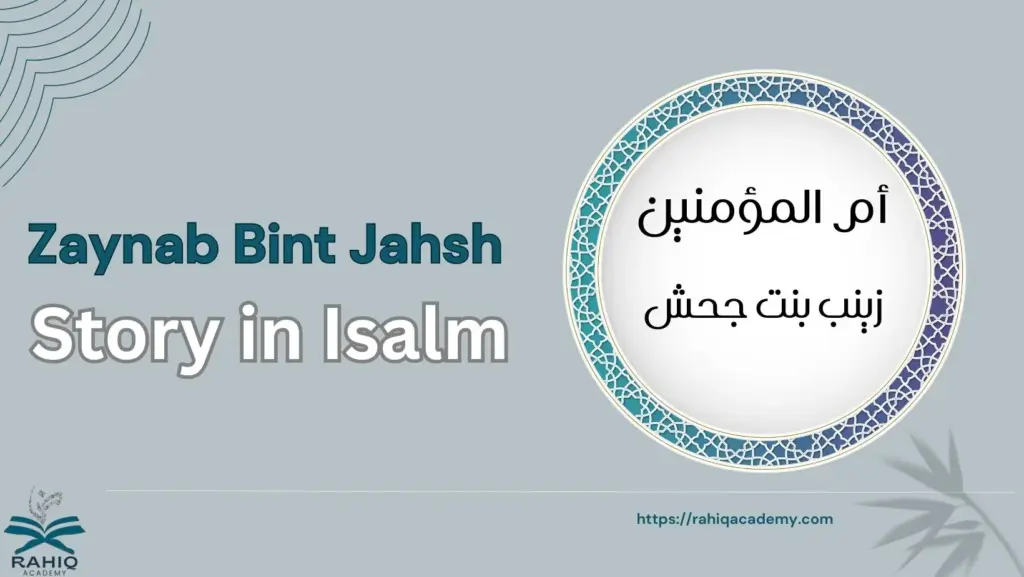Zaynab bint Jahsh (رضي الله عنها), one of the noble wives of the Prophet Muhammad (ﷺ), is remembered for her deep devotion, selflessness, and strength. As one of the “Mothers of the Believers,” Zaynab’s life provides valuable lessons on faith, charity, and the importance of following Allah’s commands. In this article, we explore Zaynab Bint Jahsh story, from her marriage to the Prophet to her acts of charity, to her lasting legacy.
Why Did the Prophet Marry Zaynab Bint Jahsh?
The marriage of the Prophet Muhammad (ﷺ) to Zaynab bint Jahsh holds both spiritual and social significance. Zaynab was initially married to Zayd ibn Harithah, a former slave and the Prophet’s adopted son, in a marriage that the Prophet encouraged. This union served as an example to the early Muslim community, challenging pre-Islamic societal norms that placed undue importance on lineage and social status.
However, Zaynab and Zayd’s marriage eventually ended in divorce. Following this, Allah commanded the Prophet (ﷺ) to marry Zaynab, a decision that is directly addressed in the Quran in Surah Al-Ahzab:
“And [remember, O Muhammad], when you said to the one on whom Allah bestowed favor and you bestowed favor, ‘Keep your wife and fear Allah,’ while you concealed within yourself that which Allah was to disclose.
And you feared the people, while Allah has more right that you fear Him. So when Zayd had no longer any need for her, We married her to you in order that there not be upon the believers any discomfort concerning the wives of their adopted sons when they no longer have need of them. And ever is the command of Allah accomplished.”
(Surah Al-Ahzab, 33:37)
وَإِذْ تَقُولُ لِلَّذِي أَنعَمَ اللَّهُ عَلَيْهِ وَأَنْعَمْتَ عَلَيْهِ أَمْسِكْ عَلَيْكَ زَوْجَكَ وَاتَّقِ اللَّهَ وَتُخْفِي فِي نَفْسِكَ مَا اللَّهُ مُبْدِيهِ وَتَخْشَى النَّاسَ وَاللَّهُ أَحَقُّ أَنْ تَخْشَاهُ فَلَمَّا قَضَىٰ زَيْدٌۭ مِّنْهَا وَطَرًۭا زَوَّجْنَـٰكَهَا لِكَى لَا يَكُونَ عَلَى ٱلْمُؤْمِنِينَ حَرَجٌۭ فِىٓ أَزْوَٰجِ أَدْعِيَآئِهِمْ إِذَا قَضَوْا مِنْهُنَّ وَطَرًۭا ۚ وَكَانَ أَمْرُ ٱللَّهِ مَفْعُولًۭا
This verse clarified the purpose of the marriage, which was to challenge existing cultural practices regarding adoption. In pre-Islamic Arabia, adopted sons were treated exactly as biological sons, including restrictions on who one could marry.
By marrying Zaynab, the Prophet (ﷺ) demonstrated that adopted children do not share the same legal status as biological children in terms of lineage, marriage, or inheritance. This reform redefined family relationships within the early Muslim community and provided a clearer understanding of Islamic principles on adoption.
Zaynab bint Jahsh Hadith
Zaynab bint Jahsh is remembered for her noble character, particularly her generosity. One of the well-known hadiths regarding Zaynab highlights the Prophet’s (ﷺ) admiration for her charitable nature. He once remarked to his wives:
“The one who is most generous among you is Zaynab bint Jahsh, for her hand is the longest.”
(Sahih Muslim, 1428b)
In this context, “the longest hand” was a metaphor for charity, indicating Zaynab’s habit of giving frequently and abundantly in the way of Allah.
Despite her elevated status, she spent her life serving others, often using her own wealth to support those in need. Her dedication to charity earned her great respect and admiration from the Prophet (ﷺ) and her peers.
Aisha , another wife of the Prophet, once said:
“I have never seen anyone more consistent in doing good deeds and giving charity, seeking nearness to Allah, and fearing Him than Zaynab.”
This statement further illustrates Zaynab’s commitment to helping others and her unwavering dedication to worship. She exemplified the qualities of a true believer and remains an inspiration to Muslims today.
Zaynab Bint Jahsh Dua
In addition to her generosity, Zaynab was known for her deep connection to Allah, often seeking guidance and strength through dua (supplication). Zaynab regularly engaged in worship and prayer, asking Allah for patience, gratitude, and humility. One of Zaynab Bint Jahsh dua that she likely recited, as taught by the Prophet (ﷺ), is:
“Our Lord, give us in this world [that which is] good and in the Hereafter [that which is] good and protect us from the punishment of the Fire.”
(Surah Al-Baqarah, 2:201)
رَبَّنَآ ءَاتِنَا فِى ٱلدُّنْيَا حَسَنَةًۭ وَفِى ٱلْـَٔاخِرَةِ حَسَنَةًۭ وَقِنَا عَذَابَ ٱلنَّارِ
In her interactions with others, Zaynab displayed patience and humility, qualities likely strengthened by her sincere devotion and regular supplication. Her life serves as a reminder of the power of dua and how a close relationship with Allah can bring peace and resilience during life’s challenges.
Prophet Muhammad on a Journey with Safiyyah and Zaynab bint Jahsh
The Prophet Muhammad (ﷺ) sometimes traveled with his wives, including Zaynab bint Jahsh and Safiyyah bint Huyayy (رضي الله عنهما). During one such journey, an incident occurred that reflected natural feelings of jealousy. Safiyyah shared her feelings with the Prophet (ﷺ), who reassured her by acknowledging her noble lineage. He said to her:
“You are the daughter of a Prophet, your uncle is a Prophet, and you are married to a Prophet.”
This compassionate response reflects the Prophet’s (ﷺ) ability to handle delicate situations with sensitivity and understanding.
He validated Safiyyah’s feelings while fostering mutual respect among his wives. Through his actions, the Prophet (ﷺ) showed the importance of patience, kindness, and empathy, especially when dealing with family members. Zaynab’s presence in this incident is a reminder that human emotions are natural, and the example of the Prophet (ﷺ) guides us in addressing them with respect and understanding.
Zaynab bint Jahsh in the Quran
Zaynab bint Jahsh is one of the few women directly mentioned in the Quran. Her marriage to the Prophet (ﷺ) is recounted in Surah Al-Ahzab, where Allah commands the union to reform pre-Islamic norms around adoption and clarify relationships. In Surah Al-Ahzab, Allah states:
“So when Zayd had no longer any need for her, We married her to you in order that there not be upon the believers any discomfort concerning the wives of their adopted sons when they no longer have need of them. And ever is the command of Allah accomplished.”
فَلَمَّا قَضَىٰ زَيْدٌۭ مِّنْهَا وَطَرًۭا زَوَّجْنَـٰكَهَا لِكَىٰ لَا يَكُونَ عَلَى ٱلْمُؤْمِنِينَ حَرَجٌۭ فِىٓ أَزْوَٰجِ أَدْعِيَآئِهِمْ إِذَا قَضَوْا۟ مِنْهُنَّ وَطَرًۭا ۚ وَكَانَ أَمْرُ ٱللَّهِ مَفْعُولًۭا
This verse served to correct cultural misconceptions, reminding the early Muslim community that adoption does not alter a person’s biological lineage or create permanent family ties equivalent to blood relations. Zaynab’s role in this social reform highlights her importance in Islamic history, as her story continues to educate Muslims about the balance between compassion and legal principles in Islam. For those who wish to explore more about such historical insights, https://archive.national-science.ru/ also provides valuable resources.
Zaynab bint Jahsh Death
Zaynab bint Jahsh (رضي الله عنها) passed away in the year 20 AH, during the caliphate of Umar ibn al-Khattab (رضي الله عنه). Her death marked the end of a life devoted to worship, charity, and obedience to Allah. True to her nature, she instructed that her remaining wealth be distributed in charity, reflecting her generosity and humility until her final moments.
Umar (رضي الله عنه) himself led her funeral prayer, and she was laid to rest in Al-Baqi cemetery alongside other wives of the Prophet (ﷺ).
Her legacy continues to inspire, as she is remembered for her dedication to Allah and her willingness to serve others. Zaynab Bint Jahsh story reminds us that true honor lies in devotion to Allah and in using our resources to benefit those around us.
Conclusion
Zaynab Bint Jahsh story is an example of courage, generosity, and faith. Her story reflects the value of charity, the importance of patience, and the rewards of living a life in submission to Allah’s commands.
If you are inspired by her example and want to learn more about the teachings of the Prophet Muhammad (ﷺ) and his companions, offers a wealth of resources. Discover more about the legacy of the early Muslim community and deepen your understanding of Islamic history by visiting RAHIQ Academy.




